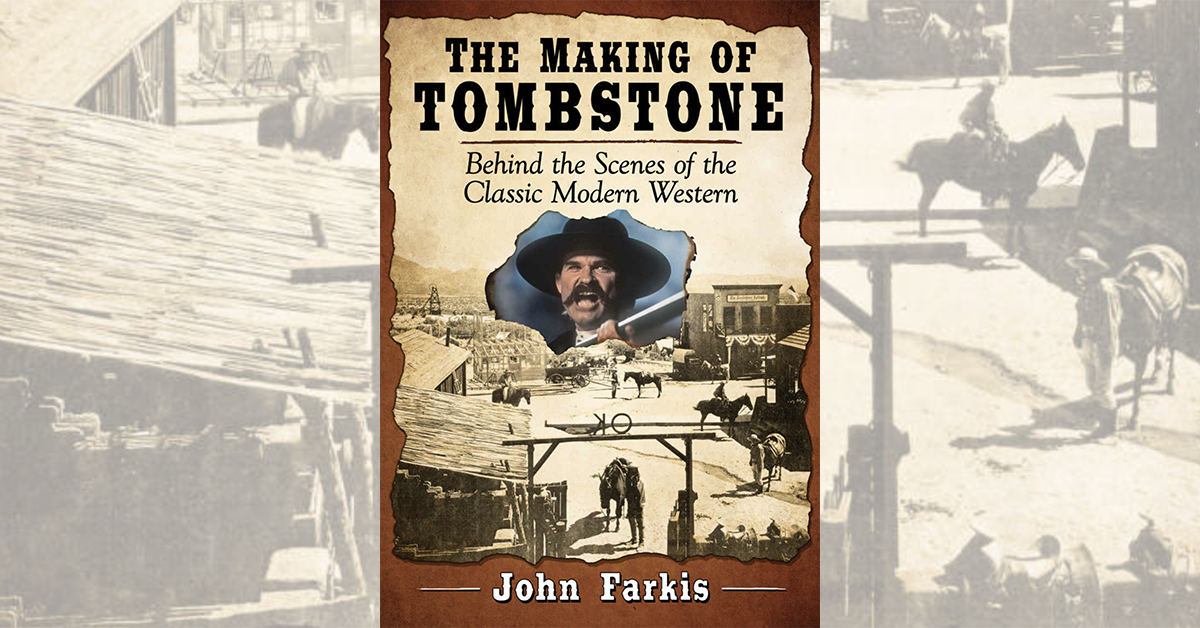The Making of Tombstone: Behind the Scenes of the Classic Modern Western, by John Farkis, McFarland & Co., Jefferson, N.C., 2018, $39.95
Books written on the making of classic Western movies have proved popular over the years. The newest entry in the genre is John Farkis’ detailed account of how the 1993 film Tombstone attained box office success and cult status in the face of many difficulties, including a chaotic midstream change of directors, a comparatively low budget, often-fierce internal dissension and opposition from such influential Hollywood forces as Kevin Costner (who was working on his own Earp film) and the powerful Creative Artists Agency (CAA). Along the way Farkis—through interviews with the actors, producers, stuntmen, cameramen, costume designers, writers and others—shares stories skillfully related to inform, amuse and, at times, infuriate the reader.
Tombstone began as a terrific script penned by gifted young writer Kevin Jarre. For those of us who can imagine no other actors in the film’s key roles, Jarre’s casting preferences are a revelation. Much as we love Kurt Russell as Wyatt Earp, he wasn’t Jarre’s first choice. Ironically, Jarre originally wanted Costner for the part, but the star was planning his own pay-per-view series on Earp and turned him down. The writer then set his sights on Irish actor Liam Neeson, with David Bowie in the role of Doc Holliday. At one point, Brad Pitt agreed to play Earp, with Johnny Depp as Doc, until Pitt’s agent at CAA advised him to drop it. A flood of other “possibles” followed, including Michael Douglas and Jeremy Irons. According to Farkis, Richard Gere so “desperately wanted to play Wyatt,” that he “just about pestered [Jarre] to death.”
And so it went with the other roles as well. It’s safe to say that no one could have played the charming, psychopathic Curly Bill better than the late Powers Boothe, but Jarre’s original choice was Tommy Lee Jones. As for the extras, Jarre insisted that those who played cowboys have their own period outfits, weapons, tack and horses and really know how to ride. He put them through rigorous tests, grading them on a 1-to-5 scale. From the hundreds of applicants he chose 30.
Finding the right studio was crucial. According to Russell, Costner did all he could to block the film’s release. “Costner had shut down all avenues of release for the picture,” the actor says, “except Disney.…He was powerful enough at the time.” Finally, Russell used his connections at Cinergi Pictures, which had a distribution arrangement with Disney, and Tombstone was allotted a modest $25 million budget. The race was on, as Tombstone and Costner’s Wyatt Earp—which had grown into a full-length feature—drove to be the first one released. Tombstone won that race, having more than doubled its budget, while Wyatt Earp crossed the finish line the proverbial day late and dollar short, gleaning tepid reviews and taking in less than half its $63 million budget.
Farkis relates this story and many others in a book that is always entertaining. He introduces each chapter with a few pages of no-frills history, effectively placing the film within its 1880s context. And he isn’t above a little gossip. “In many cases,” he writes, “I have been told the same story by several different people, so even if the stories aren’t true, maybe they should be, because they’re funnier than hell.”
Still, despite its David-and-Goliath win and deserved place in the pantheon of Westerns, it was not a happy production, Farkis says. Battling both the terrible Arizona summer heat—temps often reached well into the triple digits—and a number of “strong” personalities (that of replacement director George Cosmatos being the most caustic), Tombstone lost countless cast and production crew members, who were fired or simply refused to be bullied.
Of his own retrospective, Farkis writes, “After four books, you would think my writing would improve.” We beg to differ. He is a detail-oriented chronicler and a helluva good storyteller. The Making of Tombstone provides absorbing insight into the creation of a film many critics consider one of Hollywood’s best modern Westerns. And if anyone disagrees…well, you’re no daisy a’tall.
—Ron Soodalter





